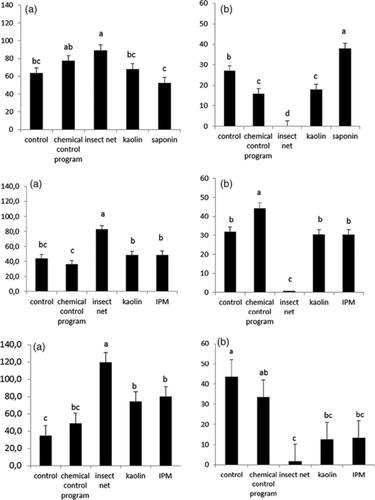当前位置:
X-MOL 学术
›
Ann. Appl. Biol.
›
论文详情
Our official English website, www.x-mol.net, welcomes your
feedback! (Note: you will need to create a separate account there.)
Assessment of the efficiency of different control programs to reduce Trioza apicalis Först. (Triozidae: Hemiptera) feeding damage and the spread of “Candidatus Liberibacter solanacearum” on carrots (Daucus carota ssp. sativus L.)
Annals of Applied Biology ( IF 2.2 ) Pub Date : 2020-07-02 , DOI: 10.1111/aab.12603 Anne I. Nissinen 1 , Juha‐Matti Pihlava 2 , Satu Latvala 1 , Lauri Jauhiainen 1
Annals of Applied Biology ( IF 2.2 ) Pub Date : 2020-07-02 , DOI: 10.1111/aab.12603 Anne I. Nissinen 1 , Juha‐Matti Pihlava 2 , Satu Latvala 1 , Lauri Jauhiainen 1
Affiliation

|
The control of carrot psyllid Trioza apicalis Förster largely relies on chemical measures, and the current integrated pest management (IPM) strategy is based on pest scouting. The number of active ingredients available for psyllid control will further decline in the coming years. The need for alternative control measures is therefore urgent. In this work the efficiency of different control programs including a kaolin particle film and plant‐derived, crude saponin extract, chemical control, insect net and IPM (kaolin in combination with insecticides) programs to reduce psyllid feeding damage, reproduction and the spread of “Candidatus Liberibacter solanacearum” (CLso) in carrots was studied. Each year in 2016–2018, four replicates of each treatment were randomised in a row‐column design on a commercial carrot farm. After the treatments were executed, the psyllid nymphs and eggs were counted. At the harvest, the carrot roots and shoots were weighed, damages assessed, and samples were taken for CLso detection from 50 plants at each replicate. Kaolin treatment alone and in combination with insecticides effectively reduced the number of psyllid nymphs and eggs in all the years studied. Saponin was applied only on the first year, since it significantly increased the number of T. apicalis eggs compared to other treatments. The insect net was superior to other treatments in all the studied aspects in all the years. Under normal weather conditions, the highest root weight was harvested under the insect net, followed by the chemical control program consisting of pyrethroids, kaolin treatment, untreated control and saponin treatment. During extreme weather conditions, chemical control programs were not effective at protecting the carrots from psyllid feeding, which was reflected as low root yield. In all years, the carrot leaf damage percent negatively correlated with the root weight. Similarly, the shoot:root ratio increased as the leaf‐curling percentage rose, which was even pronounced under drought stress. The effect of climatic stress should be considered when developing IPM strategies.
中文翻译:

评估不同控制方案减少Trioza apicalisFörst的效率。(Triozidae:半翅目)摄食损害和胡萝卜中的“ Candidatus Liberibacter solanacearum”在胡萝卜上的传播(Daucus carota ssp。sativus L.)
胡萝卜木虱Trioza apicalisFörster的防治主要依靠化学措施,而当前的病虫害综合治理(IPM)策略是基于病虫害搜寻。在未来几年中,可用于控制木虱的活性成分数量将进一步减少。因此,迫切需要替代控制措施。在这项工作中,各种控制程序的效率,包括高岭土颗粒膜和植物来源的粗皂苷提取物,化学控制,昆虫网和IPM(高岭土与杀虫剂结合)程序,可减少木虱的食性损害,繁殖和“念珠菌属研究了胡萝卜中的Solaracearum(CLso)。在2016-2018年期间,每年在商业胡萝卜农场的行-列设计中将每种处理的四次重复随机进行。进行处理后,对木虱若虫和卵进行计数。在收获时,对胡萝卜的根和芽进行称重,评估损害程度,并在每次重复时从50株植物中取样进行CLso检测。在所有研究的年份中,单独使用高岭土或与杀虫剂结合使用有效地减少了木虱若虫和卵的数量。皂苷仅在第一年使用,因为它显着增加了阿米巴虫的数量鸡蛋相比其他治疗方法。多年来,在所有研究方面,该虫网均优于其他处理方法。在正常天气条件下,在昆虫网下收获最高的根重,然后进行化学防治程序,包括拟除虫菊酯,高岭土处理,未经处理的防治和皂苷处理。在极端天气条件下,化学控制程序无法有效地保护胡萝卜免受木虱侵袭,这反映为低根产量。在所有年份中,胡萝卜叶损伤百分率与根重负相关。同样,枝条:根的比例随着叶片卷曲率的增加而增加,甚至在干旱胁迫下也很明显。制定IPM策略时应考虑气候压力的影响。
更新日期:2020-07-02
中文翻译:

评估不同控制方案减少Trioza apicalisFörst的效率。(Triozidae:半翅目)摄食损害和胡萝卜中的“ Candidatus Liberibacter solanacearum”在胡萝卜上的传播(Daucus carota ssp。sativus L.)
胡萝卜木虱Trioza apicalisFörster的防治主要依靠化学措施,而当前的病虫害综合治理(IPM)策略是基于病虫害搜寻。在未来几年中,可用于控制木虱的活性成分数量将进一步减少。因此,迫切需要替代控制措施。在这项工作中,各种控制程序的效率,包括高岭土颗粒膜和植物来源的粗皂苷提取物,化学控制,昆虫网和IPM(高岭土与杀虫剂结合)程序,可减少木虱的食性损害,繁殖和“念珠菌属研究了胡萝卜中的Solaracearum(CLso)。在2016-2018年期间,每年在商业胡萝卜农场的行-列设计中将每种处理的四次重复随机进行。进行处理后,对木虱若虫和卵进行计数。在收获时,对胡萝卜的根和芽进行称重,评估损害程度,并在每次重复时从50株植物中取样进行CLso检测。在所有研究的年份中,单独使用高岭土或与杀虫剂结合使用有效地减少了木虱若虫和卵的数量。皂苷仅在第一年使用,因为它显着增加了阿米巴虫的数量鸡蛋相比其他治疗方法。多年来,在所有研究方面,该虫网均优于其他处理方法。在正常天气条件下,在昆虫网下收获最高的根重,然后进行化学防治程序,包括拟除虫菊酯,高岭土处理,未经处理的防治和皂苷处理。在极端天气条件下,化学控制程序无法有效地保护胡萝卜免受木虱侵袭,这反映为低根产量。在所有年份中,胡萝卜叶损伤百分率与根重负相关。同样,枝条:根的比例随着叶片卷曲率的增加而增加,甚至在干旱胁迫下也很明显。制定IPM策略时应考虑气候压力的影响。











































 京公网安备 11010802027423号
京公网安备 11010802027423号